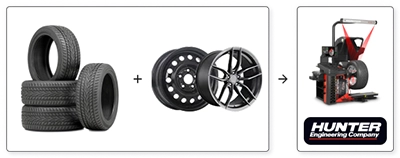Why, when and how to rotate your tires?

At PMCtire.com, we know that regular maintenance of your tires is essential to extend their life and ensure your safety on the road. Tire rotation is a crucial maintenance practice to ensure even wear and improve the performance of your vehicle. This article details why tire rotation is essential and guides you on when and how to perform it effectively.
Why rotate tires?
Even tire wear
A vehicle's tires do not wear at a uniform rate. For example, the front tires of a front-wheel drive car are under more stress due to the weight of the engine and steering mechanisms, causing them to wear faster than the rear tires. Tire rotation helps balance this wear by moving the tires from one position to another on the vehicle. This helps extend tire life, reduces the need for frequent replacements and maintains good grip on the road.
Improved performance and security
A set of unevenly worn tires can negatively affect the handling and stability of your vehicle. Evenly worn tires provide better traction and control, which is crucial, especially in harsh weather conditions. Regular tire rotation ensures that your vehicle remains stable and responsive in all driving situations.
When to rotate tires?
The ideal tire rotation frequency may vary depending on the vehicle model, tire type and your driving style. Generally, it is recommended to rotate tires every 10,000 to 12,000 kilometers. However, consult your vehicle's owner's manual for specific instructions. If you notice abnormal wear sooner than expected, it is wise to check the wheel alignment and consider an earlier rotation.
How to rotate tires?
Tire rotation patterns: The appropriate rotation pattern often depends on the vehicle type and tire configuration. Here are illustrated examples of the most common methods:
Forward cross-rotation (for front-wheel drive vehicles)
In this pattern, the front tires are moved to the rear and crossed (the right front tire goes to the left rear and vice versa), while the rear tires move to the front without changing sides.

Rear cross rotation (for rear-wheel drive vehicles)
The rear tires are moved forward on the same side, while the front tires are moved to the rear in a crossover fashion (the right front tire goes to the left rear and vice versa).

Side-to-side rotation (for four-wheel drive vehicles)
The tires are swapped from side to side, right front with left front, and right rear with left rear.

X rotation
Each tire is moved to the diagonally opposite position.

Front to rear rotation (for vehicles with the same tire dimensions front and rear)
The front tires go to the rear on the same side, and the rear tires go to the front on the same side.

Conclusion
Tire rotation is an essential part of preventative maintenance for your vehicle. At PMCtire.com, we recommend carefully following your vehicle's specific rotation instructions to maximize the life of your tires and maintain your safety on the road. For personalized advice or to purchase tires suitable for your vehicle, visit our website.
Ready to improve the performance of your vehicle?
Don't wait before it's too late ! Make sure your tires are in perfect condition. Click below to explore our wide selection of premium tires and get expert advice tailored to your needs.
Dominic Vaillancourt
Automotive expert & Spokesperson


